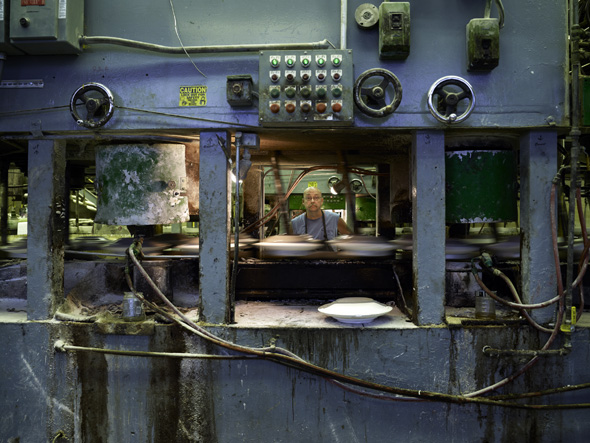You could call Carl Corey‘s work derivative, and mean no disrespect. His current project, “Blue: A Portrait of the American Worker,” grew out of his upcoming book, For Love And Money, about family businesses, which emerged from his previous book, Tavern League, about bars. “As I was doing Tavern League, I realized that most of these places were family businesses,” says Corey. “So I spent a year and a half photographing family businesses that were at least 50 years old. Some of the larger ones were factories–shipyards, a paper mill, that sort of thing. And I got interested in the workers there, and how important they are to our country.”
That led to “Blue.” Corey began the project in May 2012, and will keep at it until May 2015. When he’s finished, he hopes to have created a broad portrait of the American working class on the job.
While the photographs reproduced here present a fairly traditional conception of working-class jobs, “Blue” will, naturally, evolve to account for the changing nature of the American working class. Office workers, cashiers, baristas, and home-healthcare workers will enter Corey’s viewfinder, along with more factory and mill workers. “People who are paid by the hour or by the piece,” he says. “I want to raise awareness of the need for people to earn a living wage, a wage that allows working people to humbly raise a family. That is what is disappearing in this country.”
He was struck by the pride the people he meets take in their work, no matter how rudimentary the task; and also that management appreciates its workers, even at the larger places he visited. “There are multiple generations working in the same steel mill, or at the Woolrich plant,” he says. It is a perspective largely missing from the polarized discourse around worker-owner relations that predominates in stories about, for instance, the assault on collective bargaining in Wisconsin and elsewhere, and in the Occupy movement. Then again, he admits, “I need permission [to shoot], so maybe the only places that are letting me in are those that do care about their employees.”
The images are deliberately simple, and focused on the worker. “I’m from Chicago, so I subscribe to the whole Bauhaus thing,” Corey says. “I try not to let technique get in the way of the subject. And I never get into that lofty discussion of the aesthetics of my work, because it starts to become fluff. Just look at the picture, or the painting; read the book. I can’t really tell you why these pictures work other than they’re honest. And people appreciate honesty.”
To see all of the “Blue” photos, go to www.carlcorey.com. To learn more about the project, go to www.facebook.com/BlueDocumentary.
The Editors are the staffers of the Columbia Journalism Review.

